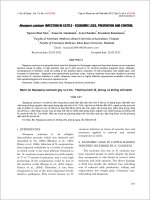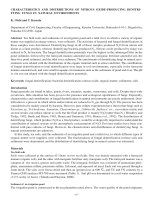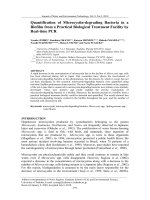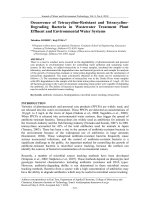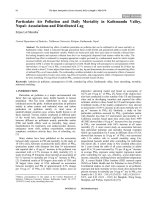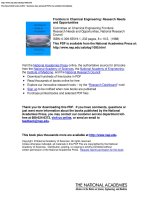probiotic bacteria in fermented foods product characteristics and starter organisms
Bạn đang xem bản rút gọn của tài liệu. Xem và tải ngay bản đầy đủ của tài liệu tại đây (131.73 KB, 6 trang )
ABSTRACT Probiotic bacteria are sold mainly in fermented
foods, and dairy products play a predominant role as carriers of
probiotics. These foods are well suited to promoting the positive
health image of probiotics for several reasons: 1) fermented foods,
and dairy products in particular, already have a positive health
image; 2) consumers are familiar with the fact that fermented
foods contain living microorganisms (bacteria); and 3) probiotics
used as starter organisms combine the positive images of fer-
mentation and probiotic cultures. When probiotics are added to
fermented foods, several factors must be considered that may
influence the ability of the probiotics to survive in the product
and become active when entering the consumer’s gastrointestinal
tract. These factors include 1) the physiologic state of the probi-
otic organisms added (whether the cells are from the logarithmic
or the stationary growth phase), 2) the physical conditions of
product storage (eg, temperature), 3) the chemical composition of
the product to which the probiotics are added (eg, acidity, avail-
able carbohydrate content, nitrogen sources, mineral content,
water activity, and oxygen content), and 4) possible interactions
of the probiotics with the starter cultures (eg, bacteriocin produc-
tion, antagonism, and synergism). The interactions of probiotics
with either the food matrix or the starter culture may be even
more intensive when probiotics are used as a component of the
starter culture. Some of these aspects are discussed in this article,
with an emphasis on dairy products such as milk, yogurt, and
cheese. Am J Clin Nutr 2001;73(suppl):374S–9S.
KEY WORDS Probiotics, lactobacilli, bifidobacteria, starter
bacteria, acidophilus milk, yogurt, kefir, cottage cheese, cheese,
fermentation, fermented foods, dairy products
INTRODUCTION
Élie Metchnikoff is considered to be the inventor of probi-
otics. Intrigued by the longevity of the Caucasian population and
its frequent consumption of fermented milks, Metchnikoff (1)
proposed that the acid-producing organisms in fermented dairy
products could prevent “fouling” in the large intestine and thus
lead to a prolongation of the life span of the consumer. Although
Metchnikoff’s ideas were clearly related to lactic acid bacteria in
dairy products, the interest of other scientists soon turned to lac-
tic acid bacteria of intestinal origin. One of the first of these sci-
entists was Henneberg (2) in Kiel, who proposed the use of an
intestinal Lactobacillus acidophilus to produce what he called
Acidophilus-Milch, or reform yogurt. When this type of fer-
mented product finally became a success under the name of
yogurt mild in Germany and some other Western European coun-
tries in the early 1980s (3), the health aspects of yogurt mild
were far less relevant than was the possibility of producing an
acid-reduced, yogurtlike fermented product. Consequently, the
lactobacillus species used for fermentation were—and still are—
selected solely on the basis of their technologic properties and
not their potential health benefits. The probiotic bacteria used in
commercial products today are mainly members of the genera
Lactobacillus and Bifidobacterium (4–7). Lactobacillus species
from which probiotic strains have been isolated include L. aci-
dophilus, Lactobacilllus johnsonii, Lactobacilllus casei, Lacto-
bacilllus rhamnosus, Lactobacilllus gasseri, and Lactobacilllus
reuteri. Bifidobacterium strains include Bifidobacterium
bifidum, Bifidobacterium longum, and Bifidobacterium infantis.
This short excursion into the history of probiotics provides a
historical explanation for why dairy products—specifically,
yogurtlike products—form the largest segment by far of the mar-
ket for probiotic products. The consequences of this history with
respect to consumer perception are that
• Fermented dairy products such as yogurt already have a
record as being healthful.
• Consumers are familiar with the fact that fermented products
contain viable microorganisms.
• Probiotics as fermentation organisms combine the positive
images of both probiotics and fermentation organisms.
• The image of yogurtlike products as healthful foods facili-
tates recommendation of daily consumption of probiotics.
In addition, there is the important technologic reason for the
use of dairy products as carriers of probiotics: many of these
products have already been optimized to some extent for survival
of the fermentation organisms. Thus, the existing technology can
be relatively easily adapted to guarantee sufficient survival of
the added probiotic bacteria. However, it must be pointed out
that other fermented products (eg, raw sausages and sauerkraut)
Am J Clin Nutr 2001;73(suppl):374S–9S. Printed in USA. © 2001 American Society for Clinical Nutrition
Probiotic bacteria in fermented foods: product characteristics and
starter organisms
1–3
Knut J Heller
1
From the Institute of Microbiology, Federal Dairy Research Center, Kiel,
Germany.
2
Presented at the symposium Probiotics and Prebiotics, held in Kiel, Ger-
many, June 11–12, 1998.
3
Address reprint requests to KJ Heller, Institut für Mikrobiologie, Bunde-
sanstalt für Milchforschung, Postfach 6069, D-24109 Kiel, Germany. E-mail:
374S
by on December 19, 2008 www.ajcn.orgDownloaded from
can serve as carriers of probiotic organisms, but few such prod-
ucts are already on the market.
With the apparent market success of probiotic products, ques-
tions concerning the nature of probiotic bacteria (4), the definition
of the term probiotic (8, 9), and the potential health effects of pro-
biotics (10, 11) are asked by consumers. Of particular importance
is whether foods containing probiotics provide added value
compared with traditional fermented foods containing living micro-
organisms, and whether this value is maintained during manufac-
turing and is provided during the entire shelf life of the product.
In this article, I address the influence of food production
technology on the functional properties of probiotics: first, pos-
sible interactions between probiotic microorganisms and food
components, and second, the effect of product and production
characteristics on the functional properties of probiotics. My
use of the term probiotic is solely conceptual and is not related
to proven health benefits.
INTERACTIONS BETWEEN PROBIOTICS AND
COMPONENTS OF FERMENTED FOODS
Besides their desired health and clinical properties, probiotics
must meet several basic requirements for the development of
marketable probiotic products. The most important requirements
are that probiotic bacteria survive in sufficient numbers in the
product, that their physical and genetic stability during storage
of the product be guaranteed, and that all of their properties
essential for expressing their health benefits after consumption
be maintained during manufacture and storage of the product. In
addition, probiotics should not have adverse effects on the taste
or aroma of the product and should not enhance acidification
during the shelf life of the product. Finally, methods should be
available to identify probiotic strains unequivocally.
To fully exploit the functional properties of probiotic bacteria,
the processes used to manufacture dairy products must be modi-
fied to meet the requirements of the probiotics. When this is not
possible, other probiotic strains must be tested or, in extreme
case, new products must be developed. In this section, I address
some of the variables necessary for or influencing the applica-
tion of probiotics in dairy products.
As with all fermented dairy products containing living bacte-
ria, probiotic products must be cooled during storage. This is
necessary both to guarantee high survival rates of the probiotic
organisms and to ensure sufficient stability of the product (12,
13). Furthermore, because the intestinal tract is considered to be
the natural environment of the probiotic bacteria, the oxygen
content, redox potential, and water activity of the medium must
be considered (14).
Active microorganisms interact intensively with their environ-
ment by exchanging components of the medium for metabolic
products. Thus, the chemical composition of the dairy product is
of paramount importance for the metabolic activities of the
microorganisms. Essential variables are the kind and amount of
carbohydrates available, the degree of hydrolysis of milk proteins
(which determines the availability of essential amino acids), and
the composition and degree of hydrolysis of milk lipids (which
determine the availability of short-chain fatty acids in particular)
(15, 16). On the other hand, the proteolytic (17) and lipolytic
properties of probiotics may be important for further degradation
of proteins and lipids. These 2 properties may have considerable
effects on the taste and flavor of dairy products (15).
A major aspect of the production of probiotic fermented dairy
products is the interaction between probiotics and starter organ-
isms. Although little is known about this interaction, both syner-
gistic and antagonistic effects between different starter organisms
are well established. For example, the classic yogurt culture is
characterized by a protosymbiosis between Streptococcus ther-
mophilus and Lactobacillus delbrueckii subsp. bulgaricus. This
synergism, seen as an accelerated and efficient acidification of
the milk and multiplication of the culture organisms and based on
cross-feeding of both organisms, is not a property of the 2 species
but of specific strains of theses species (18–21). Antagonism, on
the other hand, is often based on the production of substances that
inhibit or inactivate more or less specifically other related starter
organisms or even unrelated bacteria. Most importantly, antago-
nism is caused by bacteriocins, which are peptides or proteins
exhibiting antibiotic properties (22, 23). The ability to produce
bacteriocins is often discussed as a desirable property of probi-
otics (10); however, antagonism to starter cultures and vice versa
may be a limiting factor for combinations of starters and probi-
otics (24). Further antagonistic activities produced by lactic acid
bacteria have been described and the substances involved are
hydrogen peroxide, benzoic acid (produced from the minor milk
constituent hippuric acid), biogenic amines (formed by decar-
boxylation of amino acids), and lactic acid (25–29). An overview
of the starter bacteria used in dairy fermentations and some of
their relevant physiologic properties is given in Table 1.
The intensity of the interactions between probiotics and both
the food matrix and the starter organisms depends in large part
on the time that probiotics are added to the product, ie, whether
they are present during fermentation or are added after. In the
latter case, interactions may be minimal because addition may
occur immediately before or even after cooling below 8ЊC and
the metabolic activity of starters and probiotics is drastically
reduced at these temperatures. However, with extended storage,
even small interactions may yield measurable effects. Also, an
interruption of the cold chain must be avoided to keep interac-
tions to a minimum.
The physiologic state of the probiotics added may be of con-
siderable importance. This state very much depends on the time
of harvesting of the culture (whether during the logarithmic or
stationary phase of growth), on the conditions leading to transi-
tion to the stationary phase (this will be dealt with in more detail
in the following section), on the treatment of the probiotics dur-
ing and after harvesting, and, finally, on the composition of the
growth medium of the probiotics in relation to the composition
of the food to which they will be added. At least some ideas on
the handling of probiotics can be taken from the experience of
the production of commercial starter cultures (30).
When probiotic bacteria participate actively in fermentation,
the aspects of food composition and of interactions with the food
matrix and starters have to be taken into account on a much
larger scale. Because antagonisms between probiotics and starter
cultures will result in retarded growth or complete inhibition of
one of the bacterial components, such cases are relatively easy to
identify. One important variable in this respect is lactic acid pro-
duction and the concomitant reduction in pH during fermenta-
tion, which results in inhibition of the probiotic organisms.
The physiologic state of the probiotics is of special impor-
tance when considering how fermentation is terminated. Several
investigations showed that bacteria from the logarithmic phase
are much more susceptible to environmental stresses than are
PRODUCT CHARACTERISTICS AND STARTER ORGANISMS 375S
by on December 19, 2008 www.ajcn.orgDownloaded from
bacteria from the stationary phase (31–33). Our own experiments
with starter organisms showed that environmental factors that
signal to the bacteria the transition from the logarithmic phase to
the stationary phase may have a considerable effect on survival
rates during the stationary phase (34). Thus, a starvation signal,
triggered by depletion of carbon sources, appears to be much
more favorable for survival than a low pH in the presence of suf-
ficient carbon sources. However, investigation of stationary
phase regulation in lactic acid bacteria is a new discipline. Cer-
tainly, much more research is needed to exploit the possibilities
for improvement of survival rates of not only probiotic bacteria
but also traditional starter bacteria.
PRODUCTION AND PRODUCT CHARACTERISTICS OF
SOME FERMENTED DAIRY FOODS IN RELATION TO
USE OF PROBIOTICS
The base for the production of dairy products is milk, which
has a typical composition of Ϸ87.4% water, Ϸ4.7% lactose,
Ϸ3.8% fat, Ϸ3.3% protein, Ϸ0.2% citrate, and Ϸ0.6% minerals.
The pH of milk is usually between 6.5 and 6.7. The protein frac-
tion is composed of Ϸ80% casein and 20% whey proteins. Thus,
the nonfat dry matter of milk is between 8.5% and 9% (35).
Sweet acidophilus milk and sweet AB milk are probiotic
dairy products based on unnfermented milk. Both are produced
by adding concentrated probiotic bacteria to intensively heat-
treated milk. Heat treatment is necessary to achieve sufficient
microbiological stability during storage of the final product.
L. acidophilus and L. acidophilus plus bifidobacteria are added
to sweet acidophilus milk and sweet AB milk, respectively. In
contrast, acidophilus milk (fermented) is produced by fermenta-
tion with L. acidophilus. Again, intensive heat treatment before
fermentation, yielding almost sterile milk, is necessary for suc-
cessful fermentation because L. acidophilus acidifies slowly and
thus can be readily competed out by contaminating bacteria.
(36). A scheme for acidophilus milk production is presented in
Figure 1. (The data presented in the table and figures discussed
in this section are based on references 3, 27, and 36 and on
information from manufacturers.)
Yogurtlike products are manufactured with different textures
(3, 36). Natural-set yogurt, stirred yogurt, and drink yogurt dif-
fer in their content of nonfat solids: 16–18%, 13–14%, and
11–12%, respectively.
Considerable variation with respect to the starter culture used
is legal in some countries, including Germany. Although classic
yogurt is produced with a thermophilic protosymbiotic culture of
S. thermophilus and L. delbrueckii subsp. bulgaricus, the so-called
yogurt mild is produced with a thermophilic culture of S. ther-
mophilus and a Lactobacillus species, usually L. acidophilus.
Because of the thermophilic nature of the starter culture, fer-
mentation is usually carried out between 40 and 45ЊC. The time
needed for fermentation may be as short as 2.5 h for the classic
yogurt starter culture; this fast fermentation is mainly the result
of the protosymbiosis. Because of the rapid acidification and the
short time needed, heat treatment is not required with use of the
376S HELLER
TABLE 1
Starter organisms for dairy products
Growth temperature Lactic acid fermentation
Species
1
Minimum Optimal Maximum Homofermentative Heterofermatative Lactic acid Final pH
°C %
Lb. delbrueckii subsp. bulgaricus 22 45 52 + 1.5–1.8 3.8
Lb. delbrueckii subsp. lactis 18 40 50 + 1.5–1.8 3.8
Lb. helveticus 22 42 54 + 1.5–2.2 3.8
Lb. acidophilus 27 37 48 + 0.3–1.9 4.2
Lb. kefir 8 32 43 + 1.2–1.5 —
Lb. brevis 8 30 42 + 1.2–1.5 —
Lb. casei subsp. casei 30 + 1.2–1.5 —
S. thermophilus 22 40 52 + 0.6–0.8 4.5
Lc. lactis subsp. lactis 8 30 40 + 0.5–0.7 4.6
Lc. lactis subsp. cremoris 8 22 37 + 0.5–0.7 4.6
Lc. lactis subsp. lactis biovar. diacetylactis 8 22–28 40 + 0.5–0.7 4.6
Ln. mesenteroides subsp. cremoris 4 20–28 37 + 0.1–0.2 5.6
Ln. mesenteroides subsp. dextranicum 4 20–28 37 + 0.1–0.2 5.6
Bifidobacterium (bifidum, infantis, etc) 22 37 48 0.1–1.4 4.5
1
Lb., Lactobacillus; S., Streptococcus; Lc., Lactococcus; Ln., Leuconostoc.
FIGURE 1. The manufacturing process for acidophilus milk, both
sweet and fermented.
by on December 19, 2008 www.ajcn.orgDownloaded from
classic yogurt starter culture. Yogurt mild, on the other hand,
requires Ϸ6–8 h for fermentation, mainly because of the use of
L. acidophilus as the lactobacillus component of the starter. In
any case, a pH <4.8 is necessary to guarantee formation of a sta-
ble gel from coagulated milk protein (37). This is especially
important for natural-set yogurt.
As a result of the method used to manufacture them, stirred
yogurt and drink yogurt are well suited to the addition of probi-
otics after fermentation. Probiotics can be added easily during
stirring of the product immediately before filling of the final
containers (Figure 2). For natural-set yogurt, probiotic bacteria
must be present during fermentation because fermentation takes
place in the final containers and subsequent stirring would
destroy the product’s texture.
For the manufacture of yogurt mild, probiotic lactobacilli can
even be used as starter cultures because they meet the legal
requirements. However, such manufacture is a compromise
between full expression of the potential health properties of the
probiotic strain and the technologic suitability of the strain. The
probiotic strain must meet not only the criteria for good survival
but also the criteria for fermentation and harmonious interaction
with the S. thermophilus starter strain used. This could mean that
the strain with the best combination of functional and techno-
logic properties is the one used, not the strain with the best
health properties.
An almost ideal probiotic dairy product may be kefir because
probiotic strains have been isolated from several members of the
typical flora (eg, L. acidophilus, L. casei, and L. reuteri). How-
ever, the market potential of this product is limited because the
blown lids of the retail containers (the result of carbon dioxide
production after fermentation) apparently signal spoilage to most
consumers. A short overview over the manufacture of kefir is
presented in Figure 3.
Whereas the coagulation of milk proteins is a consequence of
acid production in yogurt, coagulation in cheese is achieved
through the proteolytic action of rennet. Less rennet is added for
fresh cheese (cheeses that do not undergo ripening) than for
ripened cheese. As an example, cottage cheese manufacture will
be described (Figure 4). Usually, milk is inoculated with a
mesophilic starter culture and incubated at between 20 and 30ЊC
for a relatively short period before rennet is added. Incubation
proceeds until the curd has formed. The curd is cut to allow
expelling of whey from the coagulated casein. Expelling is rein-
forced by raising the temperature of the whey-coagulum mixture
to 50–55ЊC for 1–2 h. During this time the coagulum particles
shrink (because of further loss of whey) and become more firm.
After the whey is drained off, the coagulum is washed with clear
water at 7–10ЊC and then at Ϸ 2ЊC to remove residual lactose.
Finally, cream and salt (and spices for some products) are added
to desired concentrations and the mixed products are poured into
retail containers.
Two options exist for adding probiotics to cottage cheese:
either with the starter culture or with the cream and salt. Addi-
tion with the starter culture is problematic for 2 reasons. First, a
considerable number of bacterial cells are lost from the coagu-
lum during draining of the whey. Thus, it is difficult to control
exactly the number of the probiotic bacteria in the final product.
Second, the scalding temperatures of ≤ 55ЊC may negatively
affect survival of the probiotic bacteria in the product. For cot-
tage cheese, therefore, it appears to be best to add probiotics
with the cream.
Many varieties of ripened cheese are known (36), but all of the
different manufacturing methods will not be discussed here, espe-
cially because ripened cheese is of only minor importance as a
carrier for probiotic bacteria. Thus, only some general and critical
PRODUCT CHARACTERISTICS AND STARTER ORGANISMS 377S
FIGURE 2. The manufacturing process for different types of yogurt.
FIGURE 3. The manufacturing process for kefir. CFU, colony-form-
ing unit.
by on December 19, 2008 www.ajcn.orgDownloaded from
aspects related to survival of probiotics will be presented
(Tab le 2). Pasteurized and prewarmed milk is inoculated with a
mesophilic or thermophilic starter culture and incubated at tem-
peratures up to Ϸ33ЊC. When the pH of the milk has dropped to a
certain value (Ϸ6.0), rennet is added and incubation is continued
until the curd has formed. The curd is cut into pieces, the sizes of
which differ according to the final product [small pieces like
wheat grains for extra hard and hard cheese, medium-sized pieces
for semihard cheese, and larger pieces (2–3-cm cubes) for soft
cheese]. Depending on the cheese variety, scalding temperatures
of ≤ 55ЊC may be applied to the curd-whey mixture. After the
whey is drained off, the curd particles are placed in molds where
they are allowed to coalesce, either by the weight of the curd or by
applied pressure. The cheese is then immersed in a brine bath and
left for the required period—from a few hours for small and soft
cheeses up to 1 mo for large and extra-hard cheeses. Often,
cheeses are not immersed in brine baths but are dry salted. Some
hard cheeses, like cheddar, are salted during milling of the
drained-off curd and are pressed in molds afterward. The duration
of ripening under controlled temperature and moisture conditions
depends on the type of cheese and can vary from a few days (soft,
surface-ripened cheese) to >2 y (extra-hard cheese).
Concerning the time of addition of probiotics and impairment
of survival by the scalding temperature, the same considerations
apply to ripened cheese as to cottage cheese. For cheeses like
cheddar that are salted, it is possible to add an exact dose of the
probiotics when the salt is added (eg, by spraying a highly con-
centrated suspension of the probiotics over the milled curd). An
additional problem in ripened cheese is caused by the long
period of ripening. It is not yet clear to what extent the different
probiotic strains will survive this period and to what extent their
functional properties will be affected. One can imagine that the
relatively high buffering capacity of the cheese matrix, the high
fat content, and the tight matrix may stabilize the probiotic bac-
teria not only during ripening but also during intestinal passage
after consumption.
Special probiotic products that are obtained by fermentation
with a single probiotic strain and that do not use one of the stan-
dard dairy products as a carrier will not be dealt with in detail
here. With such products, technologic restrictions are kept to a
minimum because fermentation is directed toward maximum
expression of the functional (health) properties of the probiotic
strain. The only “restriction” is to produce a product that will be
accepted by the consumer.
CONCLUSIONS
With the increasing popularity of probiotic products, con-
sumers frequently demand that the health properties of probiotic
strains be preserved in the products sold and that there is at least
a theoretical chance that the health effects of the probiotic strains
will be evident after consumption. To guarantee this, many
important variables must be considered by the dairy industry.
One is that sufficient numbers of probiotic cells survive through-
out the shelf life of the product. Another is that the probiotic
cells survive intestinal passage and establish themselves in the
terminal ileum or in the large intestine in sufficient numbers to
display their health effects. To ensure this, studies must show
that adverse interactions with the food matrix or with the starter
organisms of the dairy food do not play any role in this respect.
The essential measure must be that the products advertised as
being probiotic, and not just the probiotic strains added to the
products, have indeed been shown to exhibit probiotic effects.
That this is so must be made transparent to consumers by the
producers of probiotic products.
REFERENCES
1. Metchnikoff E. The prolongation of life—optimistic studies. Lon-
don: Heinemann, 1908.
2. Henneberg W. About Bacillus acidophilus and “acidophilus-milk”
(reform-yogurt). Molkerei Zeitung 1926;40:2633–5 (in German).
3. Teuber M, Geis A, Krusch U, Lembke J. Biotechnological proce-
dures for production of food and feeding-stuffs. In: Präve P, Faust
U, Sittig W, Sukatsch DA, eds. Handbuch der Biotechnologie.
(Handbook of biotechnology.) Munich, Germany: R Oldenbourg
Verlag, 1994:479–540 (in German).
4. Reuter G. Present and future of probiotics in Germany and in Cen-
tral Europe. Biosci Microflora 1997;16:43–51.
5. Holzapfel W-H, Schillinger U, Du Toit M, Dicks L. Systematics of
probiotic lactic acid bacteria with reference to modern phenotypic
and genomic methods. Microecol Ther 1997;26:1–10.
378S HELLER
TABLE 2
Critical steps in cheese manufacture
Step Conditions
Addition of starter culture Mesophilic (Lactococcus species,
Leuconostoc species)
Thermophilic (Lactobacillus helveticus,
Streptococcus thermophilus, etc)
Scalding Up to 57
o
C for up to 1 h (cheddar: Ϸ38
o
C)
Salting Brine or dry salting (cheddar: dry salting of
milled curd)
Ripening At 10–15
o
C, up to 1 y or more
(emmentaler: first 2 mo at 22–25
o
C)
FIGURE 4. The manufacturing process for cottage cheese.
by on December 19, 2008 www.ajcn.orgDownloaded from
PRODUCT CHARACTERISTICS AND STARTER ORGANISMS 379S
6. Huis in’t Veld JHJ, Havenaar R. Selections criteria and application
of probiotic microorganisms in man and animal. Microecol Ther
1997;26:43–58.
7. Bonaparte C, Reuter G. Bifidobacteria in commercial dairy prod-
ucts: which species are used? Microecol Ther 1997;26:181–98.
8. Fuller R. Probiotics in man and animal. J Appl Bacteriol 1989;
66:365–78.
9. Havenaar R, Huis in’t Veld JHJ. Probiotics: a general view. The lac-
tic acid bacteria. In: Wood BJB, ed. The lactic acid bacteria in health
and disease. Vol 1. London: Elsevier Applied Science, 1992:151–71.
10. Salminen S, Isolauri E, Salminen E. Clinical uses of probiotics for
stabilizing the gut mucosal barrier: successful strains and future
challenges. Antonie Van Leeuwenhoek 1996;70:347–58.
11. Lee Y-K, Salminen S. The coming age of probiotics. Trends Food
Sci Technol 1995;6:241–5.
12. Shah NP, Lankaputhra WEV, Britz ML, Kyle WSA. Survival of
L. acidophilus and Bifidobacterium bifidum in commercial yogurt
during refrigerated storage. Int Dairy J 1995;5:515–21.
13. Roy D, Mainville I, Mondou F. Bifidobacteria and their role in
yogurt-related products. Microecol Ther 1997;26:167–80.
14. Dave RI, Shah NP. Effect of cysteine on the viability of yogurt and
probiotic bacteria in yogurts made with commercial starter cultures.
Int Dairy J 1997;7:537–45.
15. Fox PF, Law J, McSweeney PLH, Wallace J. Biochemistry of cheese
ripening. In: Fox PF, ed. Cheese: chemistry, physics and microbiol-
ogy. Vol 1. London: Chapman and Hall, 1993:389–438.
16. Fox PF, Wallace JM, Morgan S, Lynch CM, Niland EJ, Tobin J.
Acceleration of cheese ripening. Antonie Van Leeuwenhoek 1996;
70:175–201.
17. Kunji ERS, Mierau I, Hagting A, Poolman B, Konings WN. The
proteolytic systems of lactic acid bacteria. Antonie Van Leeuwen-
hoek 1996;70:91–125.
18. Driessen FM, Kingma F, Stadhouders J. Evidence that Lactobacil-
lus bulgaricus in yogurt is stimulated by carbon dioxide produced
by Streptococcus thermophilus. Neth Milk Dairy J 1982;36:135–44.
19. Radke-Mitchell LC, Sandine WE. Influence of temperature on asso-
ciative growth of Streptococcus thermophilus and Lactobacillus
bulgaricus. J Dairy Sci 1986;69:2558–68.
20. Perez PF, De Antoni GL, Anon MC. Formiate production by Strep-
tococcus thermophilus cultures. J Dairy Sci 1991;74:2850–54.
21. Zourari A, Accolas JP, Desmazeaud MJ. Metabolism and bio-
chemical characteristics of yogurt bacteria. A review. Lait 1992;
72:1–34.
22. De Vuyst L, Vandamme EJ, eds. Bacteriocins of lactic acid bacteria.
London: Chapman and Hall, 1994.
23. Dodd HM, Gasson MJ. Bacteriocins of lactic acid bacteria. In: Gas-
son MJ, de Vos WM, eds. Genetics and biotechnology of lactic acid
bacteria. London: Blackie Academic and Professional, 1994:211–52.
24. Joseph PJ, Dave RI, Shah NP. Antagonism between yogurt bacteria
and probiotic bacteria isolated from commercial starter cultures, com-
mercial yogurts, and a probiotic capsule. Food Aust 1998;50:20–3.
25. Desmazeaud M. Growth inhibitors of lactic acid bacteria. In: Cogan
TM, Accolas J-P, eds. Dairy starter cultures. New York: VCH Pub-
lishers, 1996:131–55.
26. Sieber R, Butikofer U, Bosset JO. Benzoic acid as a natural compound
in cultured dairy products and cheese. Int Dairy J 1995;5:227–46.
27. Weber H. Starter cultures in dairy industry. In: Weber H, ed. Mikro-
biologie der Lebensmittel: Milch und Milchprodukte. (Microbiol-
ogy of food: milk and dairy products.) Hamburg, Germany: Behr’s
Verlag, 1996:105–52 (in German).
28. Lankaputhra WEV, Shah NP, Britz ML. Survival of bifidobacteria
during refrigerated storage in the presence of acid and hydrogen
peroxide. Milchwissenschaft 1996;51:65–70.
29. Leuschner RG, Heidel M, Hammes WP. Histamine and tyramine
degradation by food fermenting microorganisms. Int J Food Micro-
biol 1998;39:1–10.
30. Sandine WE. Commercial production of starter cultures. In: Cogan
TM, Accolas J-P, eds. Dairy starter cultures. New York: VCH Pub-
lishers, 1996:191–206.
31. Kolter R. The stationary phase of the bacterial life cycle. Annu Rev
Biochem 1993;47:855–74.
32. Hartke A, Bouche S, Gansel X, Boutibonnes P, Auffray, Y. Starva-
tion-induced stress resistance in Lactococcus lactis subsp. lactis
IL1403. Appl Environ Microbiol 1994;60:3474–8.
33. Rallu F, Gruss A, Maguin E. Lactococcus lactis and stress. Antonie
Van Leeuwenhoek 1996;70:243–51.
34. Wetzel K, Menzel M, Heller KJ. Stress response in Lactococcus lac-
tis and Streptococcus thermophilus induced by carbon starvation.
Kieler Milchwirtschaftl Forsch Ber 1999;51:319–32.
35. Schlimme E, Buchheim W. Milch und ihre Inhaltsstoffe. (Milk and
its contents.) Gelsenkirchen, Germany: Th. Mann Verlag, 1995 (in
German).
36. Robinson RK. A colour guide to cheese and fermented milks. Lon-
don: Chapman and Hall, 1995.
37. Rasic JL, Kurmann JA. Yogurt. Copenhagen: Technical Dairy Pub-
lishing House, 1978.
by on December 19, 2008 www.ajcn.orgDownloaded from

